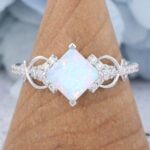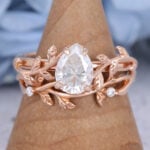The 21 Best Stones for Ring - Your Go-To Gemstone Selection Guide
From classic heirlooms to modern designs, rings have always carried deep personal meaning—and the gemstone at the center plays a vital role. In this guide, we explore luxurious gemstone insights and reveal 21 different types of stones for ring, including engagement rings and wedding rings, everyday wear and fine jewelry rings. Discover the most beautiful and meaningful gems on rings, and find the one that speaks to you.
What Makes a Good Ring Stone?
The good gemstones for ring making should meet several key criteria: beautiful appearance, high durability, color stability, and compatibility with different settings and metals.
A gemstone’s appearance includes its color, fire, and cut. When a gem is properly cut, with vivid color and strong fire, it creates a striking visual impact and often holds higher value.
Durability refers to the gemstone’s hardness on the Mohs Scale. The higher the score, the more resistant it is to scratches, making it better suited for everyday wear.
Finally, a good ring stone should be compatible with various setting styles and metal types. This ensures the gem stays secure in different designs—whether prong, bezel, or channel—and pairs well with metals like gold (yellow gold, rose gold and white gold), s925 silver, or platinum, allowing for greater flexibility and long-term wearability.
Classic Gemstone Choices for Engagement Rings
Diamond–Ultimate durability and brilliance
Diamond–Among the all different types of gemstones for engagement and wedding rings, diamonds are the most clear durable and hardest, rare, beautiful and expensive gemstones for rings. With a highest Mohs hardness of 10 (1-10), exceptional fire, and a high refractive index of 2.42, diamond delivers unmatched durability and brilliance, and the eternal meaning of diamond making it the best stone for ring special engagement rings and wedding bands.
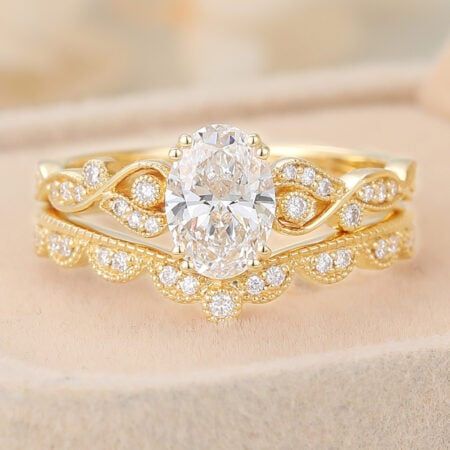
Sapphire–Durable with rich colors, especially blue
Sapphire is one of the strongest stones for ring settings and the most famous blue stones for rings, with a Mohs hardness of 9 and a refractive index of 1.76–1.77. As one of the most versatile gemstone types, it comes in pink, yellow, green, and more—but deep blue remains the most iconic and timeless.

Ruby–Symbol of passion, good hardness
Ruby is one of the most iconic names of stones in rings, known as a symbol of passion and love. With a Mohs hardness of 9, it ranks high among durable types of jewelry stones, offering rich red hues and timeless elegance for lasting wear.
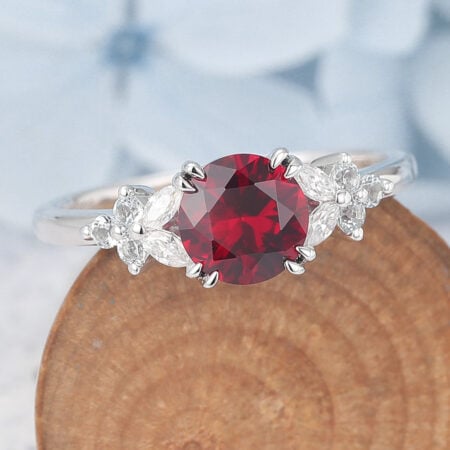
Emerald–Elegant and vibrant, though more fragile
Emerald is one of the most elegant natural green stones for rings and one of the best ring’s stone for men, admired for its vivid green color and timeless charm. Though slightly softer with a Mohs hardness of 7.5–8, it remains a prized choice among stones for ring lovers who value beauty and uniqueness. Today, lab-created emerald engagement rings are becoming an increasingly popular choice.

Moissanite–Diamond alternative with great sparkle and value
Moissanite is one of the most brilliant diamond alternatives, offering exceptional fire that even surpasses diamonds. As a durable and affordable option among stones for ring settings, it delivers stunning sparkle and clarity—making it ideal for those seeking beauty without the high price tag.
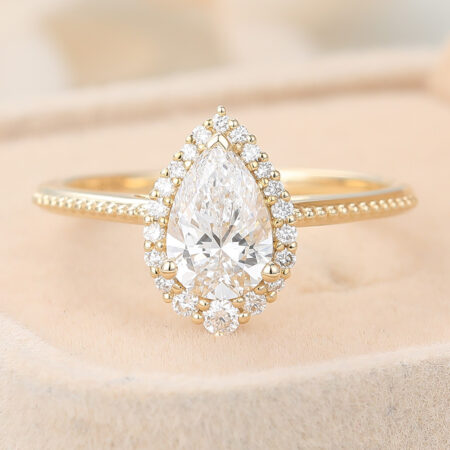
Trendy and Unique Alternatives
Morganite–Soft peach tones, romantic feel
Morganite is loved for its soft peach-pink tones and romantic, feminine appeal. Often paired with rose gold, it creates a warm and dreamy look. Though not as hard as diamonds, the pink stones remains a popular modern choice for those seeking a gentle yet unique alternative in engagement rings.

Aquamarine–Light blue and calming, suitable for everyday wear
Aquamarine offers a soft, icy blue tone with a slight greenish hue, often associated with tranquility. With a Mohs hardness of 7.5–8, it’s durable enough for daily wear. Its cool color and clarity make it a stylish and refreshing choice for modern engagement or fashion rings.

Tanzanite–Rare, deep violet-blue hue
Tanzanite is prized for its rare deep violet-blue hue, shifting between blue and purple under different lighting. With a Mohs hardness of 6–7, it requires more care but remains a captivating choice for those seeking an exotic, eye-catching gemstone in unique ring designs.
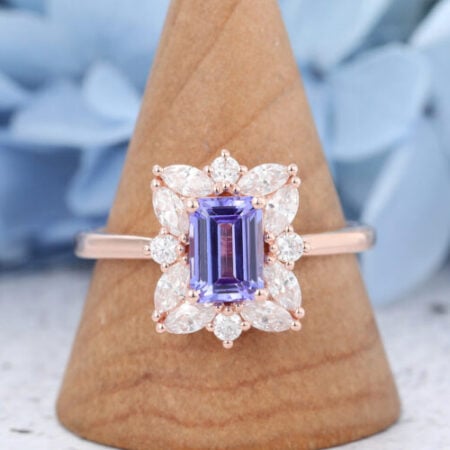
Spinel–Durable and available in a wide color range
Spinel is a durable and vibrant gemstone that comes in a wide range of colors, from vivid reds and pinks to purples and blues. Its brilliance and versatility make it a stylish alternative to more traditional stones, perfect for creating colorful and distinctive ring designs.
Tourmaline–Colorful and versatile, especially pink and green
Tourmaline is a colorful and versatile gemstone available in shades from deep green to bright pink. Its wide color range and good durability make it a popular choice for personalized ring designs, especially for those who want a bold, expressive alternative to traditional stones.
Budget-Friendly Options That Still Shine
Amethyst–Rich purple tones, perfect for statement rings
Amethyst, a popular semi-precious gemstone, features rich purple hues from deep violet to soft lavender. With a Mohs hardness of 7, it offers decent durability for everyday wear. Its affordability and vibrant color make it ideal for statement rings that stand out beautifully.
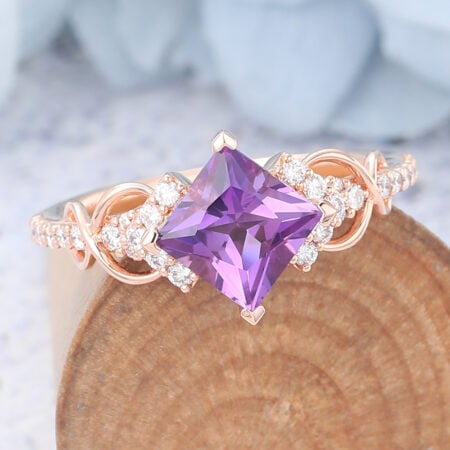
Citrine–Golden warmth with an affordable price
Citrine is valued for its warm golden-yellow tones that bring a sunny, vibrant feel to any ring. As a semi-precious gemstone with a Mohs hardness of 7, it offers good durability at an affordable price, making it a popular choice for budget-friendly yet eye-catching jewelry.
Garnet–Deep red tones, traditional yet bold
Among red gemstones, garnet stands out as a versatile and affordable choice. Compared to ruby vs garnet, garnet offers rich, deep red tones with good durability, making it ideal for everyday wear. Its striking color and reasonable price make garnet highly recommended for those seeking bold beauty without the premium cost.
Topaz–Available in blue, white, and other shades
Topaz is admired for its wide color range, including the popular London Blue variety, which captivates with its deep, elegant blue shade. Thanks to its hardness level of 8 on the Mohs scale, unusual stone topaz balances beauty and resilience, making it suitable for those seeking both style and practicality in their rings.
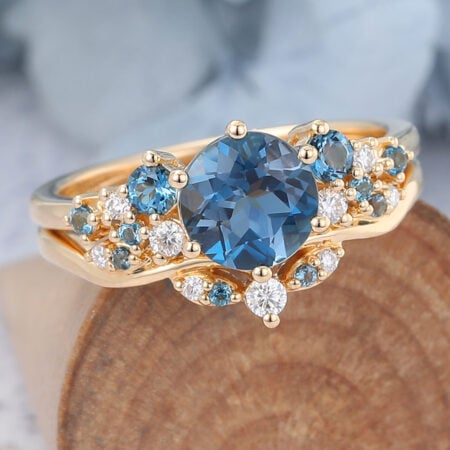
Peridot–Bright green and eye-catching
Peridot is a vibrant gemstone known for its bright, lime-green color that instantly draws attention. With a Mohs hardness of around 6.5 to 7, it offers moderate durability, making it a striking choice for rings that stand out with fresh and lively energy.
Birthstones and Their Personal Appeal
After exploring the characteristics of various stones for ring, we now turn to the traditional birthstones of the twelve months, further enriching your understanding of gemstone rings and meanings. To maintain smooth reading, previously mentioned gemstones will no longer be highlighted in bold.
- January’s birthstone is garnet, known for its rich variety of colors and symbolism of resilience and protection. It is often regarded as a symbol of passion and strength, perfect for those seeking stability and courage.
- Amethyst, the birthstone for February, features a calming purple hue representing peace and wisdom. It is believed to help relieve stress and enhance mental focus.
- March’s birthstone, aquamarine, displays a clear, tranquil color that signifies courage and serenity. Its soft blue-green tones provide a soothing effect on the mind.
- April’s birthstone is the diamond, famed for its exceptional hardness and dazzling brilliance. It symbolizes eternity and purity, embodying love and devotion.
- Emerald, the birthstone of May, shines with a vibrant green hue that represents hope and renewal. This elegant stone appeals to those who value growth and vitality.
- June’s birthstone, the pearl, moonstoneand alexandrite, exudes purity and elegance. Its gentle luster offers warmth and tranquility.
- The birthstone for July is ruby, a deep red gem symbolizing passion and love. As one of the most precious stones, ruby also stands for power and courage.
- Peridot, Spinel and Sardonyx, August’s birthstones, captivate with its bright green shade that conveys happiness and peace. Its fresh color brings a positive and energetic vibe.
- Sapphire, the birthstone for September, is known for its deep blue color symbolizing wisdom and honesty. It is believed to protect the wearer from harm.
- The Two birthstones of October : opaland tourmaline. Opal is famous for its shifting colors that inspire creativity and imagination, while tourmaline’s rich palette makes it an ideal choice for expressing individuality.
- Topaz and citrine, recognized as November’s birthstones, come in a variety of colors and represents friendship and tolerance. Their warm hues provide a comforting presence.
- December’s birthstonesare zircon, turquoise, and tanzanite. Turquoise is associated with good luck and health, whereas tanzanite’s unique violet-blue shade symbolizes mystery and distinctiveness.
How to Choose the Right Stones for Ring?
Durability First: For rings worn every day, choose stones with high Mohs hardness. Diamonds, sapphires, and rubies are excellent for their resistance to scratches and long-term wear.
Reflect Personal Style: The stone should match the wearer’s look and lifestyle. Whether it’s a timeless diamond or a playful spinel, choose what feels authentic.
Meaning Matters: Symbolism adds depth—garnet for protection, aquamarine for calm, or a birthstone for personal connection make the ring more than just decorative.
Metal and Setting Compatibility: Some stones require extra care. Softer gems like opal or pearl do best in protective settings, while durable stones like sapphire work well with most metals.
Stay Within Budget: Semi-precious options like peridot or citrine, and lab-created alternatives, offer beauty and quality without the high price of traditional precious stones.
Conclusion
Finding the perfect stones for ring settings doesn’t have to be overwhelming. Whether you love classic diamonds or want something colorful and unique, there’s a stone out there that fits your style and story. Browse Amanda’s gemstone rings collection to select your ring!
FAQs About stones for ring
Which is the best stone for a ring? what stones are good for engagement rings?
Diamonds are often considered the best stones for ring settings due to their unmatched hardness and brilliance, but other durable gems like sapphire and ruby are also excellent choices. Popular engagement ring stones include diamond, sapphire, moissanite, and emerald. These stones for ring designs combine beauty, meaning, and long-lasting durability.
Which stone should I wear in a ring?
It depends on your style, birth month, and how often you’ll wear it. Choose a stone that feels meaningful to you and suits your lifestyle—whether it’s a birthstone or a classic gem.
Can I wear rings with different gemstones?
Yes! Wearing multiple stones for ring stacking or personal expression is completely fine. Just be sure softer gems are worn with care to avoid scratches or damage.
What are the 4 precious stones?
The four traditional precious stones are diamond, ruby, sapphire, and emerald. These are valued for their rarity, beauty, and strength, making them top choices for fine jewelry.


